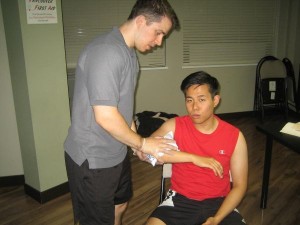Inflamed elbows are usually the result of injuries to the joint or the neighboring soft tissues including the tendons, ligaments and muscles. Always bear in mind that these injuries include tendinitis, tennis elbow and bursitis. Compression, application of ice and anti-inflammatory medications are the commonly used remedies for injuries and conditions that lead to inflamed elbows. A doctor should be consulted if the individual experiences continuous pain and swelling.
https://www.youtube.com/watch?v=xJAx42aCtSQ
What are the possible causes?
Engaging in repetitive activities in sports such as in golf and tennis can result to elbow injuries that lead to pain and inflamed elbows.
- Tennis elbow involves the tenderness of the soft tissue on the outer region of the elbow.
Compression, application of ice and anti-inflammatory medications are the commonly used remedies for injuries and conditions that lead to inflamed elbows. - Golfer’s elbow causes distension of the soft tissue on the interior of the elbow.
- Tendinitis of the elbow develops once the tendons surrounding the elbow such as the biceps tendon are inflamed and deteriorate.
Other possible causes of inflamed elbows include bursitis, fractures, bruises or even the inflammation of the bursa sac.
Adequate rest
The initial line of defense in preventing swelling is rest. The individual must avoid irritating or painful activities such as golf and tennis in order to reduce the swelling as well as prevent recurrence. In case minor elbow motions triggers pain, using a sling can help minimize the swelling and pain. Remember that getting enough rest can promote the healing process. The length of the rest period is usually based on the type and severity of the injury.
Cold therapy and compression
Application of ice and compression are highly effective remedies for inflamed elbows, especially when used along with rest. Applying an ice pack over the elbow causes vasoconstriction or constriction of the blood vessels. It also helps manage the inflammatory response of the body as well as minimizing the swelling. The application must be done 3-4 times at 20-minute intervals throughout the day.
The compression is applied by covering the limb using an elastic wrap starting at the mid-forearm up to the upper arm or shoulder. It is vital to utilize an elastic wrap all day long to push out the current swelling.
Non-steroidal anti-inflammatory drugs (NSAIDs)
Non-steroidal anti-inflammatory drugs such as ibuprofen are taken orally to help minimize the swelling. These medications work by preventing certain chemicals from being released during the inflammatory response.
Once these chemicals are restricted, the swelling is minimized. Just remember though that anti-inflammatory drugs can cause stomach upset and must be taken with food. If the individual is using other medications such as for blood pressure, a doctor should be consulted first before using anti-inflammatory drugs.
Corticosteroid injections
The corticosteroid injections can also prevent the release of chemicals during the inflammatory response, thus reducing the swelling. The main benefit of corticosteroid injections is that it is directly administered into the inflamed elbows, thus avoiding stomach upset and nausea.

